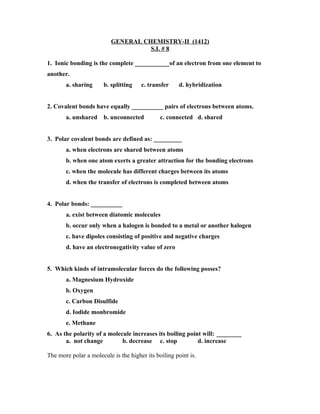Recommended
More Related Content
What's hot
What's hot (20)
Chemistry - Chp 8 - Covalent Bonding - Study Guide

Chemistry - Chp 8 - Covalent Bonding - Study Guide
Shapes And Bond Angles Of Simple Organic Compounds

Shapes And Bond Angles Of Simple Organic Compounds
Viewers also liked
Viewers also liked (20)
Similar to SI #8
Similar to SI #8 (20)
Chem 101 Spring 2017 Name _______________________________.docx

Chem 101 Spring 2017 Name _______________________________.docx
SHS STEM General Chemistry MCT 8. Chemical Bonding

SHS STEM General Chemistry MCT 8. Chemical Bonding
Chapter 11 liquids and intermolecular forces Powerpoint

Chapter 11 liquids and intermolecular forces Powerpoint
test bank Organic Chemistry, 7e Marc Loudon, Jim Parise test bank.pdf

test bank Organic Chemistry, 7e Marc Loudon, Jim Parise test bank.pdf
1- Elements are the primary types of matter- What make one element dif.pdf

1- Elements are the primary types of matter- What make one element dif.pdf
1. What types of bonding is illustrated in sharing of electr.pdf

1. What types of bonding is illustrated in sharing of electr.pdf
Science 9_Q2_Mod2_CHEMICAL BONDING PROPERTIES OF COMPOUNDS_VerFinal-2(1).docx

Science 9_Q2_Mod2_CHEMICAL BONDING PROPERTIES OF COMPOUNDS_VerFinal-2(1).docx
More from jessieo387_1412
More from jessieo387_1412 (19)
SI #8
- 1. GENERAL CHEMISTRY-II (1412) S.I. # 8 1. Ionic bonding is the complete ___________of an electron from one element to another. a. sharing b. splitting c. transfer d. hybridization 2. Covalent bonds have equally __________ pairs of electrons between atoms. a. unshared b. unconnected c. connected d. shared 3. Polar covalent bonds are defined as: _________ a. when electrons are shared between atoms b. when one atom exerts a greater attraction for the bonding electrons c. when the molecule has different charges between its atoms d. when the transfer of electrons is completed between atoms 4. Polar bonds: __________ a. exist between diatomic molecules b. occur only when a halogen is bonded to a metal or another halogen c. have dipoles consisting of positive and negative charges d. have an electronegativity value of zero 5. Which kinds of intramolecular forces do the following posses? a. Magnesium Hydroxide b. Oxygen c. Carbon Disulfide d. Iodide monbromide e. Methane 6. As the polarity of a molecule increases its boiling point will: ________ a. not change b. decrease c. stop d. increase The more polar a molecule is the higher its boiling point is.
- 2. 7. Which of the following molecules has the largest intermolecular dispersion forces? Ne or Ar ______________ F2 or Br2 ______________ N2 or Cl2 ______________ HF or HI _______________ BH3 or BF3 ______________ 8. Place in order from the highest viscosity to the lowest viscosity. Methanol Glycerol Propanol Ethanol 9. Define a phase diagram: 10. On a phase diagram, the critical temperature is ______________ a. the temperature below which a gas cannot be liquefied b. the temperature above which a gas cannot be liquefied c. the temperature at which all three states are in equilibrium d. the temperature required to melt a solid e. the temperature required to cause sublimation of a solid 11. A 0.100 m solution of which one of the following solutes will have the lowest vapor pressure? _______________ a. KClO4 b. Ca(ClO4)2 c. Al(ClO4)3 d. sucrose e. NaCl 12. When Na-Cl dissolves in water, aqueous Na+ and Cl- ions result. The force of attraction that exists between Na+ and H2O is called a(n) _________________.
- 3. NOMENCLATURE!!! 1. Methanol 2. Ethanol 3. Propanol 4. Butanol 5. Hydrazine 6. C2H5Cl 7. CH3Cl 8. Acetaldehyde 9. Propane 10. CH3I 11. C3H6O 12. Phosphine 13. HOOH 14. CH4 15. CH3CH2OH
